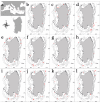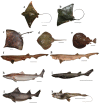Bio-Ecological Features Update on Eleven Rare Cartilaginous Fish in the Central-Western Mediterranean Sea as a Contribution for Their Conservation
- PMID: 34575020
- PMCID: PMC8471685
- DOI: 10.3390/life11090871
Bio-Ecological Features Update on Eleven Rare Cartilaginous Fish in the Central-Western Mediterranean Sea as a Contribution for Their Conservation
Abstract
Cartilaginous fish are commonly recognized as key species in marine ecosystems for their fundamental ecological role as top predators. Nevertheless, effective management plans for cartilaginous fish are still missing, due to the lack of knowledge on their abundance, distribution or even life-history. In this regard, this paper aims at providing new information on the life-history traits, such as age, maturity, reproductive period, in addition to diet characteristics of eleven rare cartilaginous fish inhabiting the Central-Western Mediterranean Sea belonging to the orders Chimaeriformes (Chimaera monstrosa), Hexanchiformes (Heptranchias perlo and Hexanchus griseus), Myliobatiformes (Aetomylaeus bovinus and Myliobatis aquila), Rajiformes (Dipturus nidarosiensis and Leucoraja circularis), Squaliformes (Centrophorus uyato, Dalatias licha and Oxynotus centrina) and Torpediniformes (Tetronarce nobiliana), useful for their assessment and for future management actions. Particularly, the present paper provides for the first time the age estimation of D. nidarosienis and L. circularis which were both found capable of becoming older than ten years. In addition, the present study updates the sizes of first maturity of C. uyato and D. licha, which appeared to be capable of reproducing earlier than what was previously hypothesized, representing very valuable information for a better understanding of these rare species populations status and, eventually, their conservation. On the basis of the stomach content analysis, it was possible to identify five different predator groups.
Keywords: Central-Western Mediterranean Sea; age; cartilaginous fish; diet; poorly-known species; reproduction.
Conflict of interest statement
The authors declare no conflict of interest.
Figures



 = F1;
= F1;  = F2;
= F2;  = F3A;
= F3A;  = F3B;
= F3B;  = F3C;
= F3C;  = F3D;
= F3D;  = F4A;
= F4A;  = F4B;
= F4B;  = M1;
= M1;  = M2;
= M2;  = M3A;
= M3A;  = M3B;
= M3B;  = M4.
= M4.
References
LinkOut - more resources
Full Text Sources

